This necklace spans years.
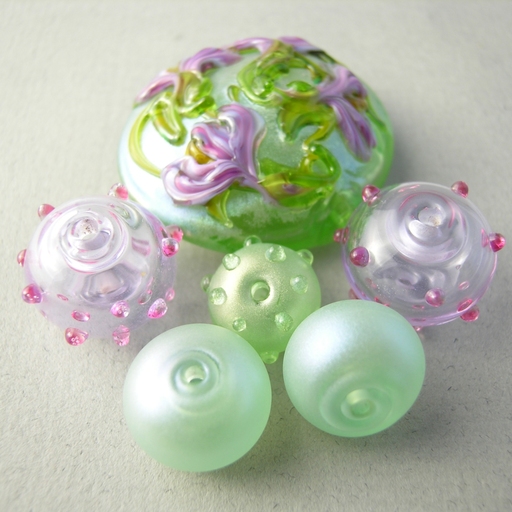
pixie dust floral lentil (flat backed); with co-ordinating alexandrite dotties, lime green pixie dotties, and mint pixies. These were shot 5feb2009.
It started with a flat-backed lentil floral pixie focal, with nicely matched pairs of beads I made into a set and put on etsy in 2009. 2009 was a financially difficult time for us, as it was for many people, and I was trying to ramp up my business again. The set failed to sell, and it failed to sell again when I last listed it in late 2012. By March of 2013, when the listing had expired, I decided that since no-one had the good taste to purchase these pretty beads, I would keep them, and make something pretty with them myself.
In 2014 I went to Japan, and met Dr Makiko Tada; we corresponded a bit, and when she told me that yes, as a matter of fact, she would be teaching in the US, I signed up for her 3 day intensive. Now, I learned kumi originally to incorporate into strung necklaces, to reduce the weight and make them adjustable; but the last one I made was at least a decade ago and most were made in 90s, iirc—at any rate, before I'd learned to make beads. I certainly wanted to show some of these older pieces in class, but thought it might be nice to have something recent as well.
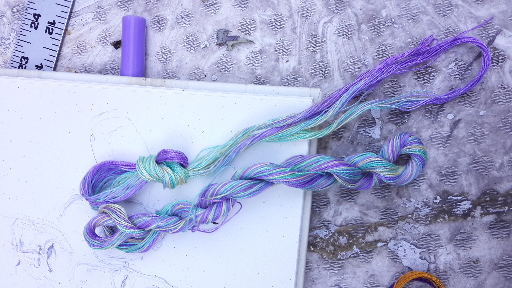
The color is very blue in this photo, but this hand-painted cotton embroidery floss matches the sample beads pretty well. 23sep2014
Braiding kumihimo with a semi-precious stone necklace acting as fukaro (counterweight) is a pain, not only because it's not necessarily the correct weight, but mostly because any kind of weight makes dressing (warping) the marudai a major pain. In the past, I'd had no choice, because I'd actually strung the beads on the braid-threads (which were silk stringing thread) but with the leopard butterfly, I switched to stringing the beads on beadalon, and then joining the braid to that. This meant I merely had to figure out how many strands of beadalon I needed—I decided on 4 (2 doubled) for each side. I had the basic idea in mind, which told me how long to cut, and then was ready to start.
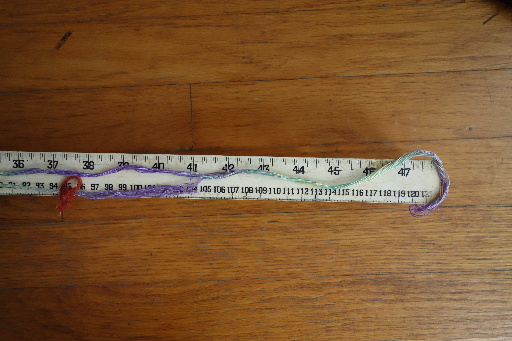
half done. Shot 31jan2015 As you can see from the photo, the uncut threads were about 100" (50x2) and the resulting braid is about 37.5" long.
Though not as constructionally elegant as braiding the actual fibers on which the beads are strung, the dual beadalon/thread approach did allow me to use ombre colored yarns for the first time,[1] since cotton is not at all suitable for stringing beads.
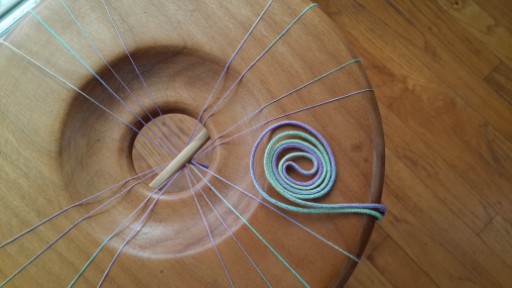
in progress, shot 22jan 2015 S4. This is the thinnest braid I've made since the black and white one from D weight silk, and it's the first one for which I used my new, tiny 62 67g Domyo school Japanese tama.
Of course, the strands were too long; so I cut them to a more-suitable 18" or so after stringing the piece, attaching traditional-style (but still plump) tassels to cover the ends.
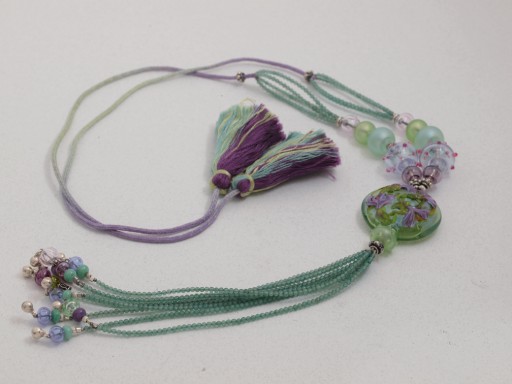
The necklace measures 28" from end of the tassel to gungroos; the opening is 33 (2x18.5) and the focal is 1.5" across. cotton, artisan made glass beads, green aventurine (the 2mm), bali & sterling silver. Completed spring 2014
The necklace bears the distinction of having only artist-made glass beads, all of which except the tiny opaques are hollow. It's also somewhat unusual in being almost perfectly symmetrical, excepting the slight variation in color amongst the bead tassel/fringe ends: very classic, and though not unknown, not so typical as the more textured, freeform approach I generally hew to.
[1]Yes, some day I should learn how to dye my own silk fibers. It's on that long, long list of things to do.
Unless otherwise noted, text, image and objects depicted therein copyright 1996--present sylvus tarn.
Sylvus Tarn